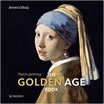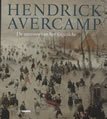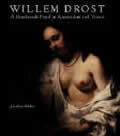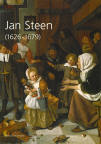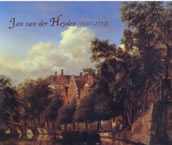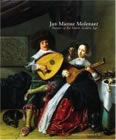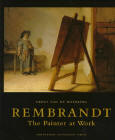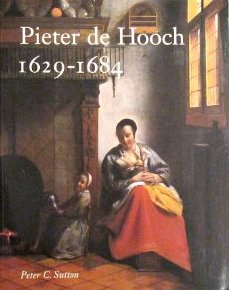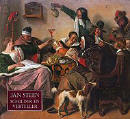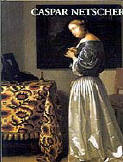By purchasing books via any of the Amazon.com or Amazon.uk links below, you will be contributing to the growth and maintenance of Essential Vermeer website, obviously, at no additional cost to your purchase.
The seventeenth century is often known as the Dutch Golden Age, not only because of the great wealth the country amassed but also because of the impressive cultural flowering that took place during this period. The art of painting in particular reached a high point, with Rembrandt, Vermeer, van Ruisdael, Jan Steen, and Van de Velde, among others. Many highly talented artists created masterpieces that still evoke our admiration more than four centuries later; their paintings are the jewels in the collections of museums all over the world. This book includes both well-known and lesser- known painters who were prominent during this period, and is an excellent visual resource.
Hendrick Avercamp (1585–1634) was the first artist to specialize in painting winter landscapes that feature people enjoying themselves on the ice. Scenes of skating, sleigh rides, and outdoor games on frozen canals and waterways bring to life the energetic pastimes and day-to-day bustle of the Golden Age. He made the "ice scene" a genre in its own right. Within these winter scenes there is also a social narrative: unencumbered by status, all classes formed one community on the ice, where they went about their daily business and celebrated the delights of the winter conditions.
For the first time in many years this virtuoso artist receives the attention he deserves. The authors explore every aspect of Avercamp's work, from the weather conditions prevalent at the time to details of the clothes worn by the figures in his crowded scenes. Avercamp was also an outstanding draftsman who made individual figure studies that he utilized not only in his painted work but also in compositional drawings.
No old master or modern artist begins to match the variety of landscapes Jacob van Ruisdael (1628/9–1682) depicted during the course of his career, nor his grandeur of conception and skill in portraying natural phenomena. His themes span identifiable towns, cities and castles; rural scenes, both cultivated and wild; seascapes and shore scenes; rivers, bridges and sluices; rushing torrents and Scandinavian waterfalls.
In this beautifully illustrated book, Seymour Slive demonstrates Ruisdael's unrivaled range and quality through a vivid evocation of his career not only as a painter, but also as a draftsman and etcher. Slive discusses the artist's clientele, early collectors and critics, as well as his influence on another preeminent landscapist, John Constable.
Turmoil and Tranquility: The Sea through the Eyes of Dutch and Flemish Masters, 1550–1700
by Jenny Gaschke2008

The National Maritime Museum is home to some of the finest 17th century Flemish and Dutch maritime paintings in the world. Turmoil and Tranquillity shows the breadth of the collection, beginning with the Flemish tradition, the development of distinctly Dutch seascapes, and the foundation of a Netherlandish school of maritime painting in Britain.
The Dutch Italianates: 17th-century Masterpieces from Dulwich Picture Gallery
by Ian A.C. Dejardin2008

Throughout the 17th century a steady stream of Dutch painters made the arduous journey to Italy, the acknowledged "home of art." Where artists of other nationalities studied the great masters of the Renaissance and the contemporary painters of the Baroque, the Dutch were electrified by the magic of Italy itself—its light, people, colors and landscape. In their paintings they recorded the glittering distances of the Roman campagna, the ruins of earlier civilizations, and the colorful characters of the streets and countryside. This volume celebrates the sheer beauty of the Dutch Italianate vision, and the virtuosity, observation and humor of these remarkable artists.
Willem Drost (1633–1659) was one of Rembrandt's most gifted pupils, and he is also considered one of the most mysterious. This book, the first ever devoted to this exceptional artist, unravels many of the mysteries of Drost's life and career. Curator and art historian Jonathan Bikker offers not only new archival evidence of the artist's date and place of death, but also a new assessment of Drost's place in the Rembrandt workshop and in the Venetian art world of the mid-17th century. Drost emerges as one of Rembrandt's most talented imitators and, despite his short career, an artist with a variety of faces.
The book features a meticulously researched and fully illustrated catalogue raisonné with 38 paintings now attributed to Drost (several formerly attributed to Rembrandt) and 35 other paintings today known only from old sale catalogues or reproductions. The author also discusses 32 paintings he rejects as Drost's work.
Jan Steen is surely the most amusing painter of the 17th century. His paintings reveal a keen interest in scenes from day to day life, for weddings and feasts, for the celebration of Saint Nicholas and the Epiphany, and never without a comical note. He is also, however, a superb painter with a unique technique and remarkable methods of working. This publication discusses the many works by Jan Steen in the Rijksmuseum, and leads on from there to explore his entire oeuvre. Besides his work the book also describes his life, his self-image and his reputation. The elusive Jan Steen was more than just a comedian and the colloquial symbol of a disorderly household; he was also a connoisseur of art and theatre and well-educated in the stories of classical mythology and the Bible. A gifted and entertaining painter, Jan Steen deserves the fullest praise.
A remarkably versatile man, Jan van der Heyden (1637–1712) was the preeminent painter of cityscapes in the Netherlands and the first artist to capture all the beauty of the urban scene. Notwithstanding his achievements as an artist, Van der Heyden was even more famous in his own time as an inventor and engineer: he invented firefighting equipment that set the standard throughout Europe for two centuries, and he perfected the streetlamp. This is the first book in English devoted to Van der Heyden. It includes recent discoveries about his fascinating life and offers an introduction to his ravishing art.
The book includes a general discussion of Van der Heyden's work, entries on 40 of his paintings, illustrations of about 100 of his paintings, as well as supplemental drawings and prints. Focusing mainly on the bustling city of Amsterdam, he also recorded other Dutch, Flemish and German cities with a brilliant palette and exceptionally detailed technique. Often innovative in his composition, he was the first artist to create imaginary scenes by rearranging existing city views and known buildings.
The first major book in English on one of the finest Dutch painters of the 17th century.
The Dutch painter Gerrit ter Borch (1617–1681) was a slightly older contemporary of Johannes Vermeer. Ter Borch's beautiful and evocative paintings were not only varied in subject but also unparalleled among his peers in capturing the elegance and grace of wealthy burghers, the shimmering surface of satin, the undulating rhythms of translucent lace cuffs, and the nuanced psychological interactions between figures in an interior scene. Indeed, ter Borch's genre scenes clearly influenced works later painted by Vermeer.
This lovely book, the first major English-language publication on ter Borch's paintings, presents a selection of some of the most outstanding works from each area of the artist's career: the remarkable early pictures of the 1630s, the midcareer genre paintings for which he is best known, and the small portraits that brought him prosperity throughout his life. Essays by noted experts on Dutch art discuss ter Borch's artistic development, the modern aspects of his paintings, and his renowned technique for painting satin.
This lavishly illustrated book is the catalogue for an exhibition at the National Gallery of Art, Washington (November 7, 2004 to January 30, 2005), and the Detroit Institute of Arts (February 28 to May 1, 2005).
Carel Fabritius 1622–1654
(Het complete oeuvre)
by Frederik J. Duparc, Ariane van Suchtelen and Gero Seelig
2004
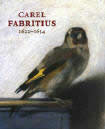
On 12 October, 1654 a powder magazine exploded in the city of Delft. This explosion had disastrous consequences not only for the city and its inhabitants but also for the art of painting, for its victims included one of the most talented artists of his time, Carel Fabritius. His studio, located a stone's throw from the powder magazine, was swept away, resulting in the loss of an unspecified portion of his oeuvre.
Nevertheless, his extant works, though small in number, are so high in quality and originality that they have earned Fabritius a place among the greatest of the Dutch Golden Age. His extraordinarily fluent brushwork made him Rembrandt's most brilliant pupil, and his bright palette and subtle treatment of light influenced Johannes Vermeer.
Pieter Claesz 1596/97–1660: Master of Haarlem Still Life
by Pieter Biesboer, Martina Brunner-Bulst, Henry D. Gregory, Christian Klemm2004
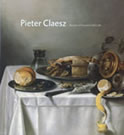
Pieter Claesz (1596/97–1660) is one of the most important still life painters of the Dutch 17th century. Born in Berchem, on the outskirts of Antwerp, he moved in 1620 to Haarlem, where he brought still life painting to unprecedented heights with his innovative approach to the genre. With an economy of means, he was able to infuse such commonplace objects as a pewter pitcher, a loaf of bread, or a simple herring with a sense of monumentality and enchanting beauty.
This richly illustrated book includes images of fifty of the finest paintings Claesz created over the course of his remarkable career. Stunning details further reveal his mastery in capturing both the texture of materials and the effects of light. The introductory essays examine the character and evolution of Pieter Claesz's style of painting, his place in the development of Dutch still life, and the various subjects that appear in his works.
Albert Eckhout traveled with Johan Maurits van Nassau-Siegen to Brazil in 1636. Eckhout made life-size illustrations of the local Brazilian population groups and created still lifes composed of exotic plants, flowers and fruits.
Quentin Buvulot's introduction addresses such topics as Eckhout as painter and draftsman (his complete oeuvre being reviewed), the function and iconography of the exhibited paintings and drawings, the artist's technique (this knowledge being based partially on recent technical research) and the donation of the paintings to the Danish king. Elly de Vries and Dante Martins Teixeira have conducted a thorough examination of the Eckhout paintings. Preceded by a short introduction, they use model drawings and detailed explanations to describe the flora, fauna and objects such as jewellery, weapons and baskets that Eckhout illustrated. The book is completed by a brief biography of Albert Eckhout written by Florike Egmond and Peter Manson as based on recent research.
Known as an obscure stranger, Michael Sweerts was one of the most creative, mysterious and most recognisable artists from the 17th century. He was a painter, an art dealer, a teacher, a deeply religious man and almost always described as an outsider who neither associated with the Dutch and Flemish artists in Rome where he stayed nor became affiliated with the official institutes of his time.
Due to his stays in Belgium, the Netherlands and Italy, the works of Sweerts combined artistic and cultural elements from Northern and Southern Europe. Sweerts painted people from the street with sympathy and respect but also painted portraits of wealthy gentlemen. He was also interested throughout his life in art education: many of his paintings have studios with students of painting as their subject. Inspiration often came from classical antiquity. Most of his paintings have secular themes, but he also created a number of historical pieces. Sweerts was also a talented printmaker who portrayed human figures for his own learning and pleasure.
Michael Sweerts contains reproductions of almost 60 paintings and etchings, thus making this book an exceptional overview of his work. This is the first publication to reproduce certain paintings from private and public collections. Also published for the first time are recent research finding. In addition, the book goes into detail about the difference in techniques used by Northern and Southern European painters.
Jacob van Ruisdael: A Complete Catalogue of His Paintings, Drawings, and Etchings
by Seymour Slive2002

In this work, every painting, drawing and etching attributable to Ruisdael is scrupulously documented and perceptively discussed. The entries are not only well illustrated but are significantly complemented by reproductions of works that suggest both the master's sources and his influence. The paintings are grouped according to topographical or thematic content, with each "subgenre" preceded by a useful introductory essay. Various chronologies, concordances, appendixes and indexes amplify the volume's contribution to the study of 17th-century Dutch art.
Pieter Saenredam, the Utrecht Work: Paintings, and Drawings by the 17Th-Century Master of Perspective
by Arie De Groot and Liesbeth M. Helmus2002

Pieter Saenredam (1597–1665) was one of the magical painters of 17th-century Holland, a time known as the Golden Age of Dutch Art. He spent his career immortalizing the churches of Holland in drawings and paintings. Working through a series of perspective drawings to the finished painting, he made innumerable fine adjustments to architectural details to create what may be justly called spaces of wondrous perfection of proportion and luminosity. Pieter Saenredam, The Utrecht Work is published to coincide with an exhibition of Saenredam's drawings and paintings, originally held at the Centraal Museum, Utrecht and on view from April 16 through July 7, 2002 at the Getty Museum. This elegant volume brings together more than sixty drawings and paintings depicting the beautiful and historically venerable churches of the Dutch city of Utrecht.
The first comprehensive examination of the paintings of Jan Miense Molenaur, one of the masters of the Dutch Golden Age.
Aelbert Cuyp was one of the foremost Dutch painters and draughtsmen of the 17th century. His prolific artistic career, in which he produced idyllic views of the Dutch countryside, spanned the years between 1640 and 1665, the Golden Age of Dutch painting. At the core of this book and the exhibition it accompanies are 45 of Cuyp's most distinguished paintings and 64 drawings, taken largely from the collections of the organizing institutions but also from other British, Dutch, American and German museums and private collections. The appeal of the work lies not only in the subject matter but also in their distinctive style. Cuyp infused his Arcadian subjects and river views with a sensitivity to light and a clarity of form that is firmly grounded in reality. The essays, by curators and scholars, discuss Cup's work in the context of his time, personal background, artistic development, patrons, use of costume and artistic techniques.
Gerrit Dou, an early pupil of Rembrandt, was one of the most highly esteemed Dutch painters of the 17th century, celebrated for the extraordinarily sensitive images he created with his fine and delicate technique. This beautiful book assembles and discusses thirty-five of his finest paintings. Founder of the Leiden school of fijnschilderen, or "fine painters," Dou had an international clientele and was lauded by the theorist Philips Angel in his 1642 treatise Lof der Schilderkonst as an artist worthy of the honour accorded the ancients. The book presents a wide range of subjects painted by Dou over the course of his career. These include portraiture, still life, and religious images as well as scenes of daily life—mothers with their children, painters in their studios, scholars, shopkeepers, schoolmasters, musicians and astronomers. Many of these works incorporate symbolic elements that Dou used to reflect the complexity of life's moral and ethical dilemmas.
Van de Wetering's approach to Rembrandt's painting eschews traditional stylistic analysis and iconographic explication in favor of examining the artist's materials and methods of painting. This technical approach is neatly conjoined with an appreciation of the artistic theory that affected the master's manner. The careful exfoliating of data derived from the laboratory about panels, canvases, underpainting, colors, binders, varnishes and so forth, along with a subtle exploitation of documentary sources, suggests a useful and fresh approaches to Rembrandtian problems. While a radical new understanding of the master's art does not emerge from this study, the Rembrandt student will be disabused of conventional notions about his painting methods, pictorial construction, use of drawing, and likely original appearance.
In Rembrandt's Eyes, Simon Schama—the leading historical craftsman of our era, with a career-long commitment to —succeeds with consummate skill in bringing the heroic painter of such masterpieces as The Night Watch and Portrait of Jan Six vividly to life. Returning to the bustling Dutch world with which he first made his reputation in the bestselling Embarrassment of Riches (1987), Schama re-creates Rembrandt's life and times with all the verve and panache of a historical novelist—while never for an instant losing his scrupulous grip on recorded fact and detail.
This beautiful book examines the art of Pieter de Hooch, one of the most famous and innovative painters of Holland's Golden Age. It discusses de Hooch's position in Dutch genre painting, his favorite themes and their cultural context, his artistic development, and his approach to narration.
The director of the Wadsworth Atheneum, Sutton has written an accessible monograph that, updates his earlier catalogue of the artist's work and serves as the catalog for a de Hooch exhibition appearing in London and Hartford. Sutton has achieved the rare feat of creating a work that is both a significant addition to scholarship and a reader-friendly introduction for those not already familiar with the artist.
Jan Steen, the quintessential 17th-century Dutch painter, set himself apart from other painters with an astonishing range of brushwork skills and diversity of themes and genres. Although he is best known for his paintings of ambiguous scenes set in inns or of doctors visiting patients he also painted sensitive portraits, depicting the upper classes with great skill, as well as religious and mythological scenes. Forty-five of Steen's finest works have been carefully selected to exemplify both the exceptionally wide range and superb quality of his work.
The book demonstrates the mastery of an artist whose touch could be both meticulous and slipshod. It also provides a sample of his uniquely comical view of human behaviour. This lavishly illustrated book shows Steen`s consummate skill as painter and storyteller, reassesses the artist in the context of his times, and presents the most comprehensive biographical profile of Steen yet published.
Judith Leyster (1609–1660), the most famous woman painter of the Dutch golden age, was remarkable for her time. She pursued a profession dominated by men, was the only female member of the painter's guild known to have had a workshop, and is the sole woman artist whose known work attests to an active role in the open market, then a relatively new form of art patronage that was to transform the Dutch art world. This book gives new insights into Leyster's world—her life, her art, and the society in which she lived. Written by a team of scholars that includes art historians, economic historians, and painting conservators, the book discusses Leyster's life, the close link between art and the economy in Holland at this time, the social factors affecting Leyster and other working women in the 17th century, the lives of the major painters who were her contemporaries, the nature of Leyster's painting technique and style, and the unique qualities of her art. The second half of the book reproduces Leyster's paintings—including her captivating scenes of everyday life—and analyses each in detail. Carefully selected paintings by other artists of the period, including Frans and Dirck Hals and Leyster's husband, Jan Miense Molenaer, are also presented in order to place Leyster's work in the context of Haarlem genre painting at its height.
The study begins with a biography of Netscher and overview of critical reception, followed by an analysis of his Oeuvre and his contribution to the development of a new artistic mode in the late 17th. century.
